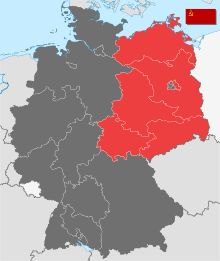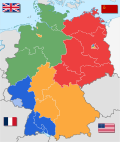Soviet occupation zone in Germany
| Soviet occupation zone in Germany Sowjetische Besatzungszone Советская оккупационная зона Германии | |||||||||
|---|---|---|---|---|---|---|---|---|---|
| Military occupation zone of the Soviet Union | |||||||||
 The Soviet occupation zone in red | |||||||||
| Capital | Berlin | ||||||||
| Government | |||||||||
| • Type | Military occupation (member of the Eastern Bloc) | ||||||||
| Military governors | |||||||||
• 1945–1946 | Georgy Zhukov | ||||||||
• 1946–1949 | Vasily Sokolovsky | ||||||||
• 1949 | Vasily Chuikov | ||||||||
| Historical era | Post-World War II Cold War | ||||||||
| 8 May 1945 | |||||||||
• German Democratic Republic established | 7 October 1949 | ||||||||
| |||||||||
| Today part of | Germany | ||||||||
The Soviet occupation zone in Germany (German: Sowjetische Besatzungszone (SBZ) or Ostzone, lit. 'East Zone'; Russian: Советская оккупационная зона Германии, romanized: Sovetskaya okkupatsionnaya zona Germanii) was an area of Germany that was occupied by the Soviet Union as a communist area, established as a result of the Potsdam Agreement on 2 August 1945. On 7 October 1949 the German Democratic Republic (GDR), commonly referred to in English as East Germany, was established in the Soviet occupation zone.

The SBZ was one of the four Allied occupation zones of Germany created at the end of World War II with the Allied victory. According to the Potsdam Agreement, the Soviet Military Administration in Germany (German initials: SMAD) was assigned responsibility for the middle portion of Germany. Eastern Germany beyond the Oder-Neisse line, equal in territory to the SBZ, was to be annexed by Poland and its population expelled, pending a final peace conference with Germany.[1]
By the time armed forces of the United States and United Kingdom began to meet Soviet Union forces, forming the Line of Contact, significant areas of what would become the Soviet zone of Germany were outside Soviet control. After several months of occupation, these gains by the British and Americans were ceded to the Soviets by July 1945, according to the previously agreed occupation zone boundaries.
The SMAD allowed four political parties to develop, though they were all required to work together under an alliance known as the "Democratic Bloc" (later the National Front). In April 1946, the Social Democratic Party of Germany (SPD) and the Communist Party of Germany (KPD) were forcibly merged to form the Socialist Unity Party which later became the governing party of the GDR.
The SMAD set up ten "special camps" for the detention of Germans, making use of some former Nazi concentration camps.


In 1945, the Soviet occupation zone consisted primarily of the central portions of Prussia. After Prussia was dissolved by the Allied powers in 1947, the area was divided between the German states (Länder) of Brandenburg, Mecklenburg, Saxony, Saxony-Anhalt and Thuringia.[2] On 7 October 1949, the Soviet zone became the German Democratic Republic. In 1952, the Länder were dissolved and realigned into 14 districts (Bezirke), plus the district of East Berlin.
In 1952, with the Cold War political confrontation well underway, Joseph Stalin sounded out the Western Powers about the prospect of a united Germany which would be non-aligned (the "Stalin Note"). The West's lack of interest in this proposal helped to cement the Soviet Zone's identity as the GDR for the next four decades.
"Soviet zone" and derivatives (or also, "the so-called GDR") remained official and common names for East Germany in West Germany, which refused to acknowledge the existence of a state in East Germany until 1972, when the government of Willy Brandt extended a qualified recognition under its Ostpolitik initiative.

See also
[edit]- Allied-occupied Austria
- History of East Germany
- Bizone
- Trizone
- Group of Soviet Forces in Germany
- Stunde Null
References
[edit]- ^ Geoffrey K. Roberts, Patricia Hogwood (2013). The Politics Today Companion to West European Politics. Oxford University Press. p. 50. ISBN 9781847790323.; Piotr Stefan Wandycz (1980). The United States and Poland. Harvard University Press. p. 303. ISBN 9780674926851.; Phillip A. Bühler (1990). The Oder-Neisse Line: a reappraisal under international law. East European Monographs. p. 33. ISBN 9780880331746.
- ^ Peterson, Edward N. (1999). Russian commands and German resistance : the Soviet Occupation, 1945–1949. New York: P. Lang. p. 5. ISBN 0-8204-3948-7. OCLC 38207545.
- Brennan, Sean, 'Land Reform Propaganda in Soviet Occupied Germany', University of Kent
- Lewkowicz, NicolasThe German Question and the International Order, 1943–48 (Palgrave Macmillan: Basingstoke and New York) (2008)
- Lewkowicz, Nicolas, The German Question and the Origins of the Cold War (IPOC: Milan) (2008)
- States and territories established in 1945
- Soviet occupation zone
- 1940s in East Germany
- Foreign relations of the Soviet Union
- World War II occupied territories
- Aftermath of World War II in Germany
- Allied occupation of Germany
- Soviet military occupations
- Germany–Soviet Union military relations
- States and territories disestablished in 1949
- 1945 in Germany
- 1945 establishments in Europe
- 1949 disestablishments in Europe



